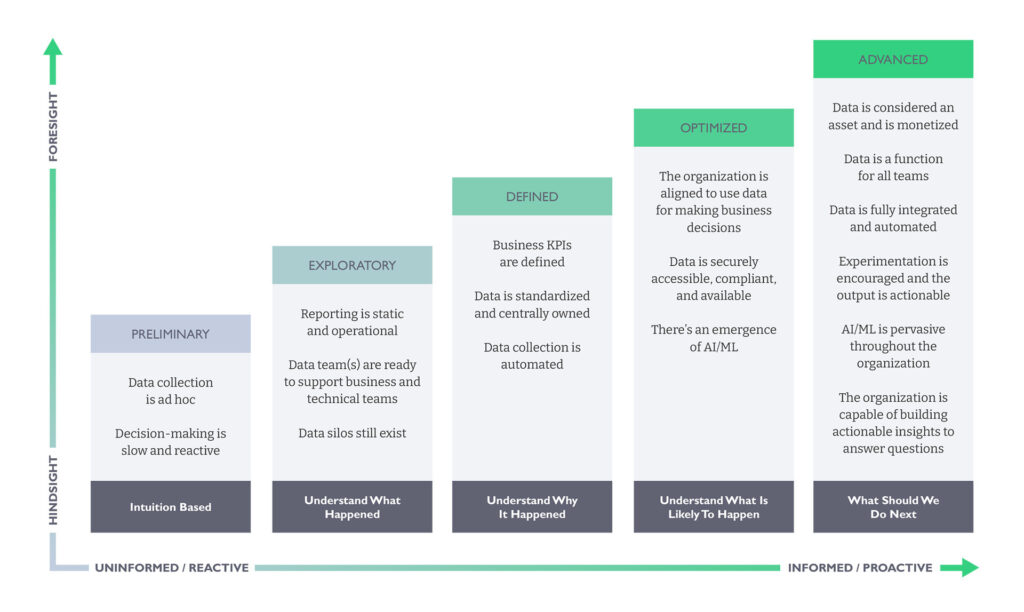A Framework to Analyze Your Data & Analytics Capabilities
The real estate industry has experienced a notable shift towards data-driven decision-making. As organizations strive to refine their processes, enhance customer and tenant experiences, and improve business outcomes, harnessing data and analytics provides them with a distinct competitive edge. However, the challenge lies in determining where to start this transformative journey.
To aid in assessing your organization’s data management and analytics capabilities, we’ve developed a framework to determine your current data maturity level. The following criteria are used to measure your baseline:
- Data Strategy: Evaluate your organization’s data strategy for clarity and alignment with business objectives. Focus on people and processes rather than technology.
- Data Governance: Assess your existing processes to ensure data security, accuracy, availability, and accessibility.
- Organizational Readiness: Gauge your organization’s data-driven culture and determine whether internal experts are sufficient or if external resources are required.
- Data Management: Review your data storage, infrastructure scalability, and adherence to data management best practices.
- Analytics Potential: Evaluate the effectiveness of your analytics tools, techniques, and methodologies in generating actionable insights and reducing manual efforts.
These variables or data points are then consolidated into a composite score, which represents your organization’s maturity level. This spectrum ranges from limited or ad-hoc data practices to heightened levels of sophistication and integration. It’s important to note that not all organizations follow a linear path through these stages. Some might skip stages or even experience regression due to changes in leadership, business priorities, or technology.
Let’s review the five data maturity stages and their descriptions.
Preliminary: Business data is stored in multiple sources (spreadsheets and underutilized business applications), and is inaccessible across your departments. There is no data governance in place, and integrated reporting is manual–taking weeks or months to complete. Therefore, decision-making hinges on intuition rather than data-driven insights. This leads to data mistrust, lack of transparency, and slow decision-making capabilities.
Exploratory: Business leaders are advocating for application adoption to improve contact and work management. Inter-department data sharing is getting better but remains manual, and data governance is developing with defined metrics. Automated integrations between your ERP (e.g. Yardi, MRI, and JD Edwards) and business applications start to enhance your reporting capabilities.
Defined: Business leaders are using applications and reports to elevate department meetings and streamline cross-department operations, ensuring accurate data capture. This effort is reinforced by a consensus on the source of truth, yielding cleaner handoffs through improved processes and automated integrations. As data governance includes broader metrics, accountability takes root across your organization. Additionally, a data warehouse is in development to automate data integration into a unified model, enabling comprehensive reporting.
Optimized: Integrated insights and automation are seamlessly integrated into business applications, resulting in enhanced and expedited business operations. The organization understands cross-departmental operations and assigns data responsibilities. Additionally, a self-service layer is established within the data warehouse, granting your entire organization access to trusted integrated data for individual and team use, supplementing standard reporting. A central data repository is enriched with increasing volumes of external data, such as demographics, foot traffic, comps, and competitor intelligence. This augmentation improves integrated reporting, leading to predictive insights.
Advanced: Business leaders benefit from real-time insights into departmental operations through business applications. Automated executive and deal committee materials offer integrated insights and facilitate prompt responses to inquiries. The synchronization of your data and operations allow for streamlined external reporting to investors, brokers, and tenants, offering them self-service experiences akin to employees. Additionally, data-savvy business users can independently construct and evaluate predictive and prescriptive models, identifying novel opportunities and providing crucial support for informed decision-making.
The key takeway to remember from all of this information is that the starting point or baseline of your organization’s data management and capabilities is not crucial. What holds greater significance is recognizing your initial level of maturity and then developing a roadmap to leverage data to drive towards alignment with your business objectives. This approach enables your organization to take targeted actions to reach higher levels of data maturity setting you up for more effective decision-making capabilities.


